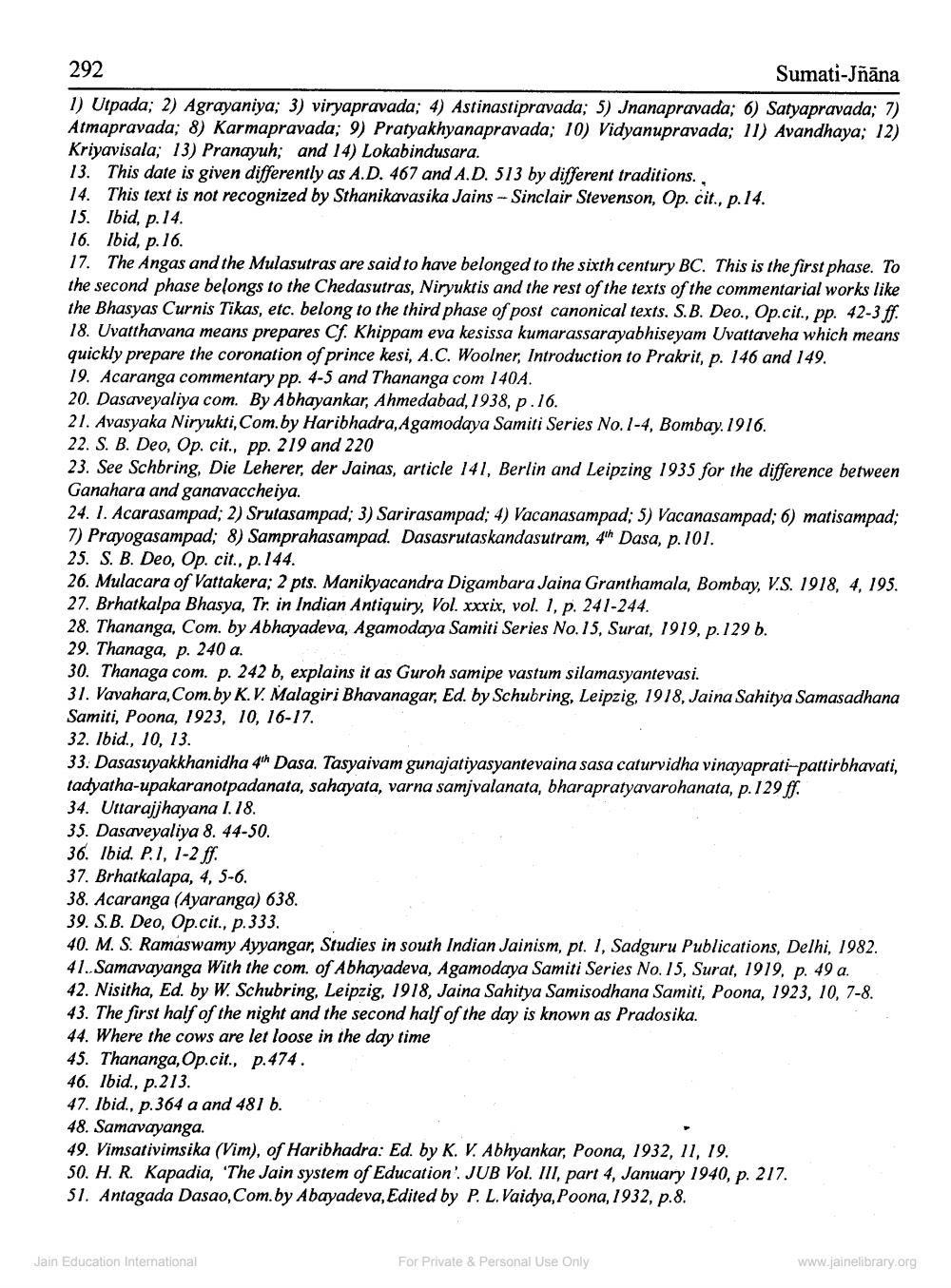________________
292
Sumati-Jñäna
1) Utpada; 2) Agrayaniya; 3) viryapravada; 4) Astinastipravada; 5) Jnanapravada; 6) Satyapravada; 7) Atmapravada; 8) Karmapravada; 9) Pratyakhyanapravada; 10) Vidyanupravada; 11) Avandhaya; 12) Kriyavisala; 13) Pranayuh; and 14) Lokabindusara.
13. This date is given differently as A.D. 467 and A.D. 513 by different traditions.
14. This text is not recognized by Sthanikavasika Jains-Sinclair Stevenson, Op. cit., p. 14.
15. Ibid, p.14.
16. Ibid, p.16.
17. The Angas and the Mulasutras are said to have belonged to the sixth century BC. This is the first phase. To the second phase belongs to the Chedasutras, Niryuktis and the rest of the texts of the commentarial works like the Bhasyas Curnis Tikas, etc. belong to the third phase of post canonical texts. S.B. Deo., Op.cit., pp. 42-3 ff. 18. Uvatthavana means prepares Cf. Khippam eva kesissa kumarassarayabhiseyam Uvattaveha which means quickly prepare the coronation of prince kesi, A.C. Woolner, Introduction to Prakrit, p. 146 and 149. 19. Acaranga commentary pp. 4-5 and Thananga com 140A.
20. Dasaveyaliya com. By Abhayankar, Ahmedabad, 1938, p.16.
21. Avasyaka Niryukti, Com. by Haribhadra, Agamodaya Samiti Series No. 1-4, Bombay. 1916. 22. S. B. Deo, Op. cit., pp. 219 and 220
23. See Schbring. Die Leherer, der Jainas, article 141, Berlin and Leipzing 1935 for the difference between Ganahara and ganavacchelya
24. 1. Acarasampad; 2) Srutasampad; 3) Sarirasampad; 4) Vacanasampad; 5) Vacanasampad; 6) matisampad 7) Prayogasampad; 8) Samprahasampad. Dasasrutaskandasutram, 4 Dasa, p. 101.
25. S. B. Deo, Op. cit., p. 144.
26. Mulacara of Vattakera; 2 pts. Manikyacandra Digambara Jaina Granthamala, Bombay, VS. 1918, 4, 195. 27. Brhatkalpa Bhasya, Tr. in Indian Antiquiry, Vol. xxxix, vol. 1, p. 241-244.
28. Thananga, Com. by Abhayadeva, Agamodaya Samiti Series No. 15, Surat, 1919, p. 129 b.
29. Thanaga, p. 240 a.
30. Thanaga com. p. 242 b, explains it as Guroh samipe vastum silamasyantevasi.
31. Vavahara, Com.by K.V. Malagiri Bhavanagar, Ed. by Schubring, Leipzig, 1918, Jaina Sahitya Samasadhana Samiti, Poona, 1923, 10, 16-17.
32. Ibid., 10, 13.
33. Dasasuyakkhanidha 4 Dasa. Tasyaivam gunajatiyasyantevaina sasa caturvidha vinayaprati-pattirbhavati, tadyatha-upakaranotpadanata, sahayata, varna samjvalanata, bharapratyavarohanata, p. 129 f
34. Uttarajhayana 1.18.
35. Dasaveyaliya 8. 44-50.
36. Ibid. P.1, 1-2 ff.
37. Brhatkalapa, 4, 5-6.
38. Acaranga (Ayaranga) 638.
39. S.B. Deo, Op.cit., p.333.
40. M. S. Ramaswamy Ayyangar, Studies in south Indian Jainism, pt. 1, Sadguru Publications, Delhi, 1982. 41...Samavayanga With the com. of Abhayadeva, Agamodaya Samiti Series No. 15, Surat, 1919, p. 49 a.
42. Nisitha, Ed. by W. Schubring, Leipzig, 1918, Jaina Sahitya Samisodhana Samiti, Poona, 1923, 10, 7-8. 43. The first half of the night and the second half of the day is known as Pradosika.
44. Where the cows are let loose in the day time
45. Thananga, Op.cit., p.474.
46. Ibid., p.213.
47. Ibid., p.364 a and 481 b.
48. Samavayanga.
49. Vimsativimsika (Vim), of Haribhadra: Ed. by K. V. Abhyankar, Poona, 1932, 11, 19.
50. H. R. Kapadia, 'The Jain system of Education'. JUB Vol. III, part 4, January 1940, p. 217. 51. Antagada Dasao, Com.by Abayadeva, Edited by P. L.Vaidya, Poona, 1932, p.8.
Jain Education International
For Private & Personal Use Only
www.jainelibrary.org




